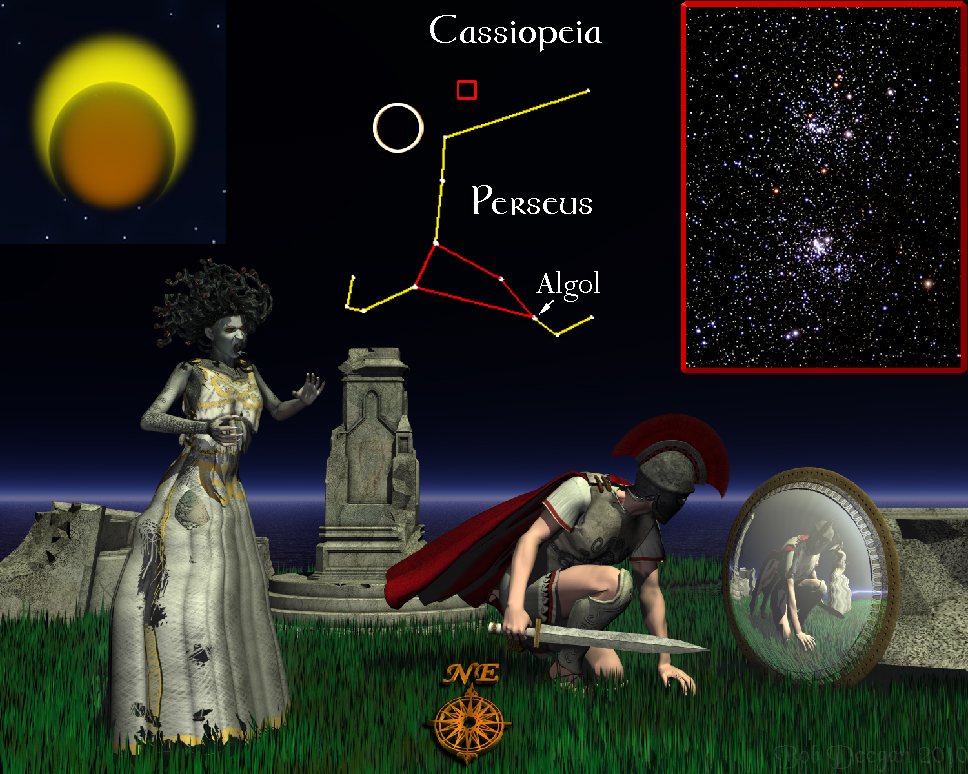
For the week including August 13, 2010

THE PERSEIDS
This week the annual Perseid meteor shower reached its peak as the Earth passed through the core of debris left behind by Comet Swift-Tuttle. The Perseids will be coming down for another week or so and are always fun to watch. Although the meteors will often fall in bunches, observers can expect to see at least one or two meteors a minute rush across the sky. Swift-Tuttle orbits the Sun every 130 years and passed near us in 1992, leaving a fresh trail of small particles in its wake. When the minute debris fragments streak through the Earth’s atmosphere they burn up in our skies as meteors, providing a wonderful light show.
A good way to observe the Perseids is to dress warmly and head out around 11pm to a dark place where you have an unrestricted view to the northeast. You may want a lawn chair and thermos of coffee too. When you’re all set up, look to the northeast and you will see the constellation of Cassiopeia as a large “W” composed of fairly bright stars. Beneath it and close to the horizon is the constellation of Perseus; its brightest central stars form a rough triangle. Observing the meteors won’t take any special effort; they’ll come to you. The meteors will stream from a broad area of the northeastern sky, but if you trace their paths backward, they will seem to be streaming from an area inside the boundaries of Perseus (circled in our illustration) that gave this meteor shower its name. As the Earth rotates, the meteor shower will get better as the stars of Perseus rise higher above the horizon.
While you’re watching the meteors, there is a wonderful and strange star to look for as well.
Probably the most famous story from the Greek legends of the warrior Perseus was his battle with the Gorgon named Medusa. Once a very beautiful woman, the gods punished Medusa’s vanity by turning her into a hideous demon with snakes for hair. Anyone who looked directly at her turned to stone, which curtailed much of her previously active social life. Although her growing collection of statuary was getting pretty famous, few were willing to visit her misty island to see it. Perseus was willing to take up the challenge and there with the aid of his shield, polished to serve as a mirror, targeted Medusa’s reflection and beheaded her with a sword. No charges were filed and a major motion picture would eventually follow.
The head of Medusa is among the stars of Perseus and her winking eye is marked by the star Algol. Algol is actually a pair of stars that orbit each other like the lobes of a propeller. Every 2.87 days, the fainter of the two stars crosses in front of its brighter companion causing Algol to slowly dim to almost one-third its normal brightness before gradually coming back to normal. This entire process is visible to the naked eye over a period of less than six hours. A good time to catch this star’s dimming will come on the morning of August 19th, when Algol reaches its minimum brightness around 1:30am EDT. An easy way to gauge the changes in Algol is by comparing it to the star immediately to its right. Normally, Algol (modeled at upper left) looks twice as bright as this star, but at minimum Algol will be noticeably the fainter of the two.
Shown in the photograph by Neil Fleming at upper right, the Double Cluster (visible in the squared area) is among the most visually striking deep-sky landmarks. Each cluster measures some seventy light years across and the stars they contain evolved together out of a huge cloud of gases and dust. An average pair of binoculars will easily bring it into view and because of its northern position in our skies, the Double Cluster is visible for most of the year.
Unless otherwise indicated, all content of this web site is the copyright of Robert Deegan and all rights are reserved.
For more information, or to comment, please contact: Bob@NightSkies.org